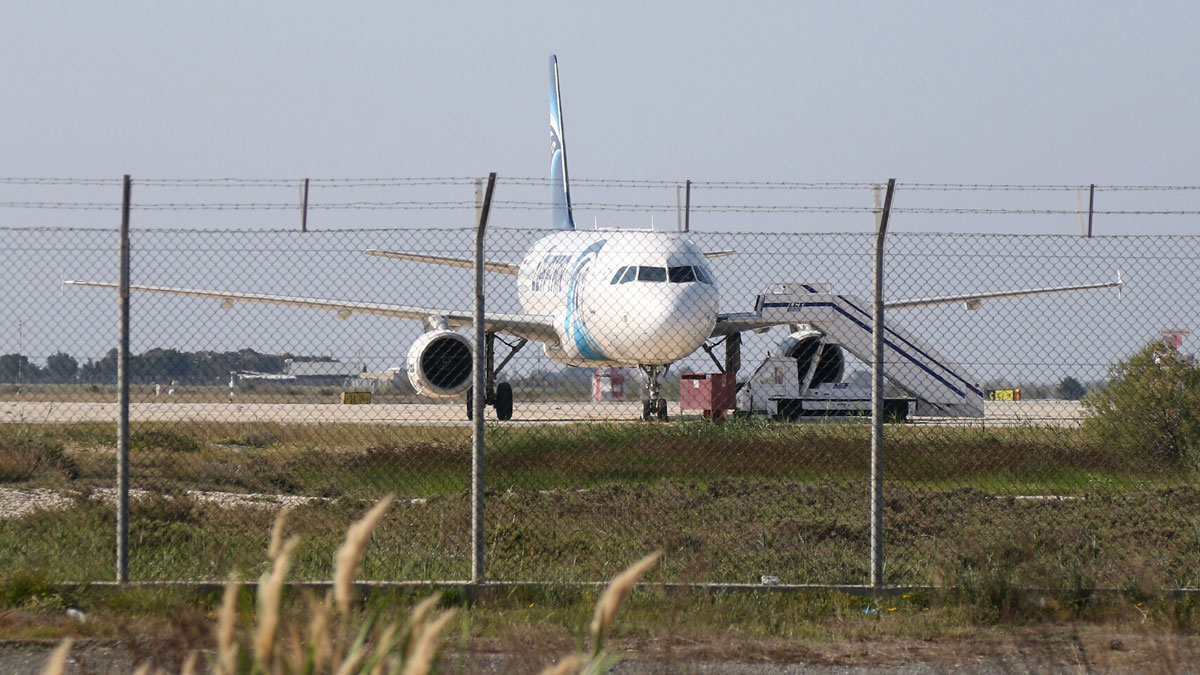EgyptAir hijacker was violent and dangerous, claims ex-wife
Marina Paraschou denies Seif el-Din Mustafa was motivated by love to make fake suicide belt

The former wife of the EgyptAir hijacker, Seif el-Din Mustafa, has claimed that he is "extremely dangerous", subjected her to domestic abuse during their marriage and was a habitual drug user.
Cypriot Marina Paraschou said the media's portrayal of the hijacking as a romantic gesture was mistaken and added: "This man used my name only and simply as an excuse to come to Cyprus and ask for [political] asylum."
On Tuesday, Mustafa used a fake suicide belt to force the captain of EgyptAir MS181 to fly to Larnaca, Cyprus, instead of completing a scheduled trip from Alexandria to Cairo. After a five-hour standoff, he surrendered to police.
The Week
Escape your echo chamber. Get the facts behind the news, plus analysis from multiple perspectives.

Sign up for The Week's Free Newsletters
From our morning news briefing to a weekly Good News Newsletter, get the best of The Week delivered directly to your inbox.
From our morning news briefing to a weekly Good News Newsletter, get the best of The Week delivered directly to your inbox.
During the hostage crisis, Cypriot authorities were "stunned" when the man they had believed to be a terrorist threw a letter addressed to Paraschou out of the plane, says The Guardian.
Speaking to the press for the first time since the incident, Paraschou said: "Most of the media painted a picture of romance in which a man was trying to reach out to his estranged wife.
"But that couldn't be further from the truth and they would have a different opinion if they knew what he was really like.
"It was a very black period, full of threats, beating, torture and terror from a man who knew how to produce fear and spread unhappiness around him."
A free daily email with the biggest news stories of the day – and the best features from TheWeek.com
Paraschou, a law graduate, married Mustafa in 1985 when she was 20 and he was 26. She went on to have four children with him.
She said he had then disappeared for decades, even failing to turn up for the funeral when one of his daughters died. She added: "For 25 years he never remembered that he had a wife and children. Now he's remembered?"
A spokesman for the Cyprus government confirmed that Mustafa had been deported three times from the island on charges of domestic violence and harassing his ex-wife.
He said: "He knew Cyprus well and lived here until 1994. After that he was deported three times on charges of harassing his wife. On at least one occasion he got back into the country using a fake passport."
EgyptAir hijacker 'wanted to see wife and family'
31 March
The man who hijacked an EgyptAir flight with a fake suicide belt on Tuesday says he just wanted to see his wife and family.
Seif Eldin Mustafa told police he had not seen his Cypriot wife, nor his children, for 24 years because "the Egyptian government doesn't allow it", although it was not clear how the government had prevented their meeting.
Mustafa appeared in court yesterday in Larnaca, the southern Cypriot city to which he diverted flight MS181 after showing a stewardess a belt made of plastic bottles and pieces of wire.
The judge ordered him to be held in custody for another eight days on suspicion of hijacking, abduction, threatening violence, terrorism-related offences and two counts related to possession of explosives.
The 59-year-old Egyptian flashed a "V" peace sign at photographers as he left.
Cypriot investigating officer Andreas Lambrianou told the court Mustafa had hijacked the plane 15 minutes into its scheduled flight from Alexandria to Cairo.
"The suspect asked all passengers and crew to hand in their passports then gave two messages to a member of the crew, asking that the pilot be informed that he was a hijacker and wanted to land at an airport in Turkey, Greece or Cyprus, but preferably Cyprus," he said.
"In a note, he stressed that if the airplane landed on Egyptian territory he would immediately blow up the plane."
When the plane landed at Larnaca, added Lambrianou, Mustafa dropped a letter to his ex-wife onto the runway. In the note, he demanded the release of 63 female prisoners held in Egypt, says Al Jazeera.
He also allegedly gave the pilot permission to release all of the Egyptian hostages on board, leaving just four Europeans and the crew. The remaining hostages were released five hours later, when Mustafa surrendered.
Briton Ben Innes explains why he took photo with EgyptAir hijacker
30 March
A British man held hostage on EgyptAir flight MS181 said he felt he had "nothing to lose" when he asked to have his photograph taken with the hijacker.
The image of Ben Innes grinning as he stands alongside Seif Eldin Mustafa, who wears what is now known to be a fake suicide belt, spread rapidly across social media during yesterday's hijacking.
Innes, originally from Leeds but now living in Aberdeen, was returning from a business trip when the flight to Cairo was diverted to Cyprus after Mustafa allegedly threatened to detonate a suicide belt.
The Brit made his unusual request half an hour after the plane landed at Larnaca airport.
"I got one of the cabin crew to translate for me and asked [Mustafa] if I could do a selfie with him," he told The Sun. "He just shrugged OK, so I stood by him and smiled for the camera while a stewardess did the snap."
Innes then sent the image to friends via WhatsApp and remained on board the plane until Mustafa surrendered peacefully several hours later.
Ironically, Innes works as a health and safety auditor but said he "threw caution to the wind" when the idea came to him.
"I thought, 'Why not? If he blows us all up it won't matter anyway,'" he said. "I figured if his bomb was real, I'd nothing to lose anyway, so took a chance to get a closer look at it."
Innes's friends said the daring stunt was very much in character. One university pal told the Daily Telegraph that Innes was a "wild man" who was "very much into his banter".
Security experts were less impressed, however. Will Geddes, the founder of International Corporate Protection, told The Sun that Innes's behaviour was "selfish" and "highly irresponsible".
EygptAir jet hijacker arrested and hostages freed
29 March
A man who allegedly hijacked an Egyptian passenger jet and forced the pilot to land in Cyprus has been arrested and all hostages released, according to EgyptAir.
Flight MS181 was making a short internal hop from Alexandria to Cairo this morning when a passenger apparently told the captain he was wearing a belt of explosives.
The hijacker has been named as Seif Eldin Mustafa by Cypriot officials, although there is confusion about his motives. Some reports suggest he asked to speak to a European Union representative while others say he wanted to talk to his estranged wife in Cyprus.
Cypriot President Nicos Anastasiades says the hijack was not a terrorist incident. Asked by reporters whether Mustafa was motivated by romance, Anastasiades laughed and said: "Always there is a woman involved."
The Airbus A320 left Alexandria at 6.36am local time this morning with six crew, a security official and 56 passengers on board, including four Britons, eight Americans, four Dutch, two Belgians, two Greeks, a French national, an Italian and a Syrian.
Most of them were released when the plane landed at Larnaca airport, on the south coast of Cyprus, but up to nine people reportedly remained on board, including the pilot, the co-pilot and a female stewardess.
Pictures and video footage from the scene showed four people leaving the aircraft, one of whom climbed out of a cockpit window.
[[{"type":"media","view_mode":"content_original","fid":"92796","attributes":{"class":"media-image"}}]]
It was unclear during negotiations whether the hijacker had actually taken explosives on board or whether he was bluffing.
The incident comes five months after a Russian plane crashed in the Sinai desert, minutes after taking off from the Egyptian resort Sharm el-Sheikh with 224 people on board.
The latest events will "bring to the fore again the question of security at Egyptian airports", says The Guardian.
-
 Political cartoons for December 20
Political cartoons for December 20Cartoons Saturday’s political cartoons include drowning rats, the ACA, and more
-
 5 fairly vain cartoons about Vanity Fair’s interviews with Susie Wiles
5 fairly vain cartoons about Vanity Fair’s interviews with Susie WilesCartoon Artists take on demolition derby, alcoholic personality, and more
-
 Joanna Trollope: novelist who had a No. 1 bestseller with The Rector’s Wife
Joanna Trollope: novelist who had a No. 1 bestseller with The Rector’s WifeIn the Spotlight Trollope found fame with intelligent novels about the dramas and dilemmas of modern women
-
 How Bulgaria’s government fell amid mass protests
How Bulgaria’s government fell amid mass protestsThe Explainer The country’s prime minister resigned as part of the fallout
-
 Femicide: Italy’s newest crime
Femicide: Italy’s newest crimeThe Explainer Landmark law to criminalise murder of a woman as an ‘act of hatred’ or ‘subjugation’ but critics say Italy is still deeply patriarchal
-
 Brazil’s Bolsonaro behind bars after appeals run out
Brazil’s Bolsonaro behind bars after appeals run outSpeed Read He will serve 27 years in prison
-
 Americans traveling abroad face renewed criticism in the Trump era
Americans traveling abroad face renewed criticism in the Trump eraThe Explainer Some of Trump’s behavior has Americans being questioned
-
 Nigeria confused by Trump invasion threat
Nigeria confused by Trump invasion threatSpeed Read Trump has claimed the country is persecuting Christians
-
 Sanae Takaichi: Japan’s Iron Lady set to be the country’s first woman prime minister
Sanae Takaichi: Japan’s Iron Lady set to be the country’s first woman prime ministerIn the Spotlight Takaichi is a member of Japan’s conservative, nationalist Liberal Democratic Party
-
 Russia is ‘helping China’ prepare for an invasion of Taiwan
Russia is ‘helping China’ prepare for an invasion of TaiwanIn the Spotlight Russia is reportedly allowing China access to military training
-
 Interpol arrests hundreds in Africa-wide sextortion crackdown
Interpol arrests hundreds in Africa-wide sextortion crackdownIN THE SPOTLIGHT A series of stings disrupts major cybercrime operations as law enforcement estimates millions in losses from schemes designed to prey on lonely users